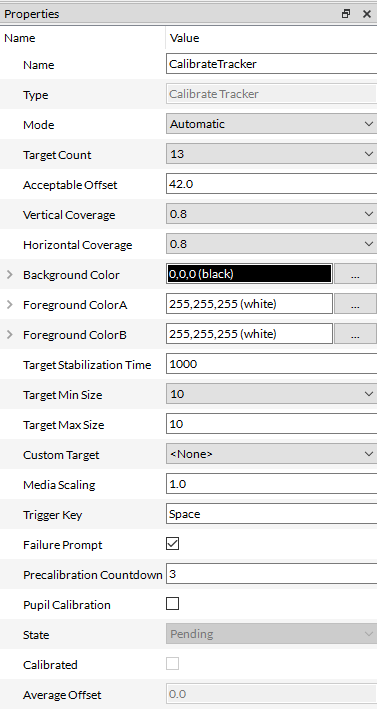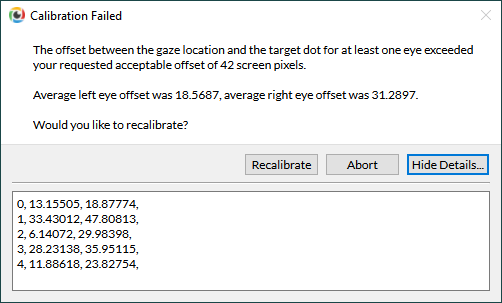Calibrate Tracker
Calibration routine for eye tracker. Specify the number of target dots and other details of the calibration procedure.
Thank you for your interest in LabMaestro! The page you are trying to access is under development. We are working on comprehensive documentation to help you make the most of our software. If you require any help, please feel free to contact us via email at support@vpixx.com.
The Calibrate Tracker command displays visual targets at pre-determined screen coordinates, and sample eye tracker data accordingly. Eye-tracking calibration is necessary to collect and report data in a calibrated screen pixel space. The Calibrate Tracker command features several customizable properties, such as various modes, number of targets, and background and target appearance.

Screen capture from Lab Maestro 1.7.0
Mode: The calibration procedure used to display calibration targets and collect gaze samples
Automatic: During an automatic calibration, a calibration target is presented for the duration specified by Target Stabilization Time, after which gaze samples are automatically collected.
Triggered: Tracker sampling begins only when the participant explicitly confirms that they are fixating on the target, by pressing the Trigger Key.
Manual: This advanced mode requires two displays and active experimenter control. Please contact VPixx support (support@vpixx.com) for more information.
Target Count: Indicates the number of calibration targets used in the calibration process.
Up to 25 target locations can be used to calibrate the eye tracker, and calibrations can be run using various subsets of these 25 calibration targets. A subset of size n contains the first n calibration targets defined in
2 | 14 | 6 | 16 | 4 |
18 | 10 | 22 | 12 | 20 |
8 | 24 | 1 | 25 | 9 |
21 | 13 | 23 | 11 | 19 |
5 | 17 | 7 | 15 | 3 |
The standard calibration grid for a 16:9 aspect ratio display is 13-point calibration grid. The following tables represent the relative position of the targets for common selections, in black against a blue background:
Acceptable Offset: Indicates the threshold for calibration target offset in screen pixels. This value should be modified based on your requirements. See Calibration failure prompt for more details.
Vertical Coverage: Specifies the proportion of the screen height to be calibrated, in percent of the total screen height. Default setting is 80 percent: this corresponds to 19.3 degrees of visual angle vertical tracking range at a 57.3 cm viewing distance (+/- 9.65 DVA from the center of the screen)
Horizontal Coverage: Specifies the proportion of the screen width to be calibrated, in percent of the total screen width. Default setting is 80 percent: this corresponds to a 35.5 degrees of visual angle horizontal tracking range at a 57.3 cm viewing distance (i.e., +/- 17.75 DVA from the center of the screen).
Background Color: Specifies the calibration screen background color.
Foreground Color A: Specifies the first color of the calibration target.
Foreground Color B: Specifies the second color of the calibration target.
Each calibration target will alternate at 5 Hz between the colors specified by ForegroundColorA and ForegroundColorB over the course of Target Stabilization Time. If the values specified by both ForegroundColorA and ForegroundColorB are the same, the calibration target colors will not alternate.
Target Stabilization Time: Specify the number of milliseconds before the gaze samples are collected, for each target. If the target properties include size or color changes, they will be animated during this time.
Target Min Size: Indicates the minimum radius of each calibration target, in pixels.
Target Max Size: Indicates the maximum radius of each calibration target, in pixels.
Each calibration target may be animated such that the radius linearily decreases in size from the value specified by TargetMaxSize to the value specified by TargetMinSize over the course of Target Stabilization Time. If the values specified by both TargetMaxSize and TargetMinSize are the same, no resizing will occur.
Custom Target: Optionally select an image or video media from your project’s Resources , to use as a calibration target.
Media Scaling: Magnification factor used to resize the media used as a custom target.
Trigger Key: When calibration mode is set to triggered, this specifies the keyboard input key which initiates gaze sampling for the current calibration target.
Failure Prompt: When failure prompt is enabled, if the calibration fails, a dialog box will automatically open with diagnostic information about the calibration results.

Failure prompt dialog box which opens if calibration has failed. The columns of the Details data are, in order: Calibration target ID (n-1), left eye offset, and right eye offset. Screen capture taken from an example failed 5-point calibration, in LabMaestro 1.7.0.
Precalibration Countdown: Presents a countdown from the specified value, before beginning the calibration procedure. If the pre-calibration countdown is set to 0, no countdown will be shown.
State: A read-only property describing the state of the calibration:
Pending: The Calibrate Tracker component not been reached yet.
Ongoing: The calibration procedure defined by the Calibrate Tracker component is currently being executed.
Succeeded: The previous calibration procedure attempt, defined by the Calibrate Tracker component was completed successfully.
Failed. The previous calibration procedure attempt, defined by the Calibrate Tracker, either failed or was aborted.
Calibrated: Read only property reporting whether the calibration sequence was completed successfully (see Acceptable Offset),
Average Offset: The average offset between the gaze location and the target dot, calculated on the eyes identified in Eye Selection, on the Setup TRACKPixx3 screen.